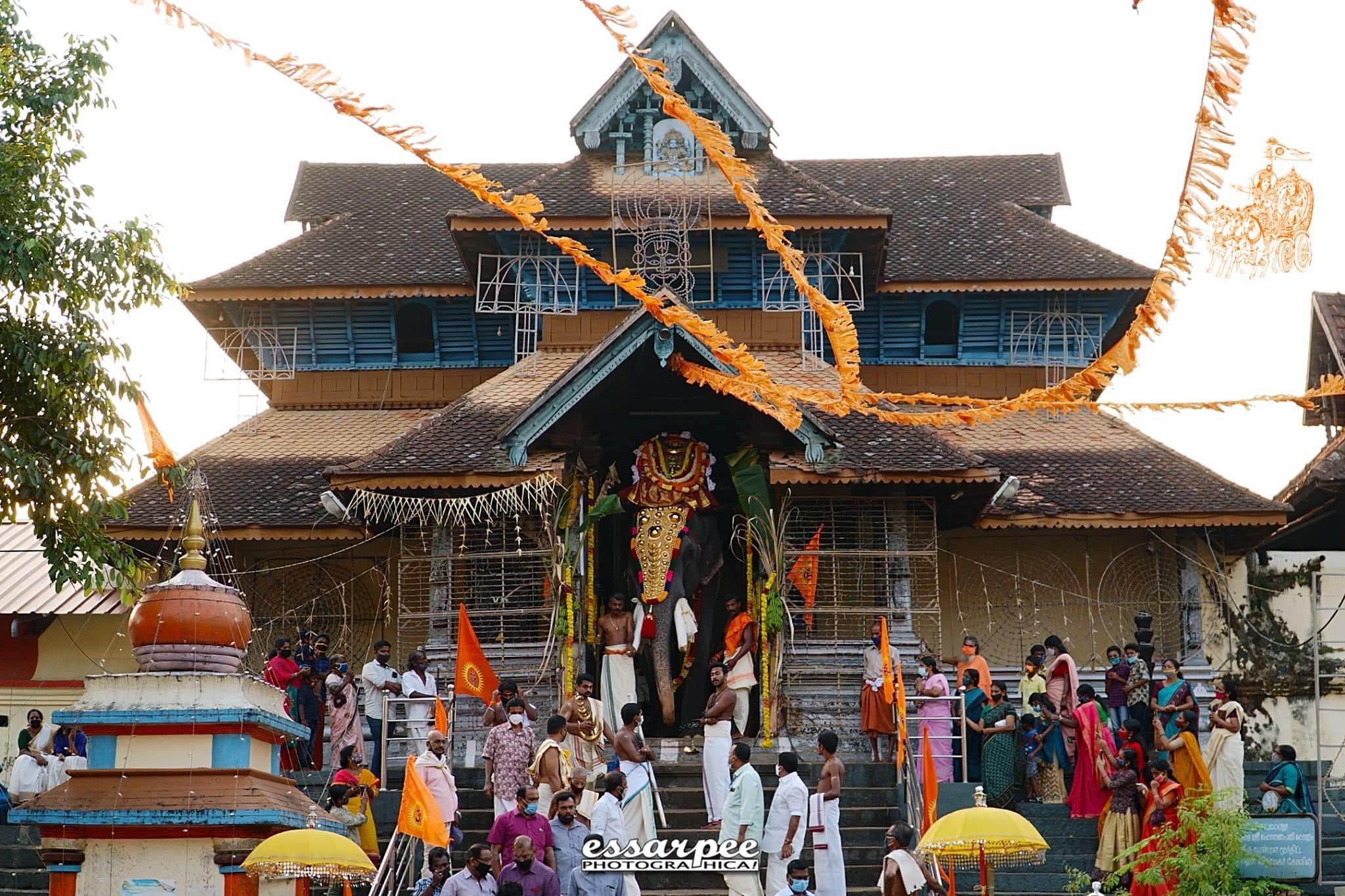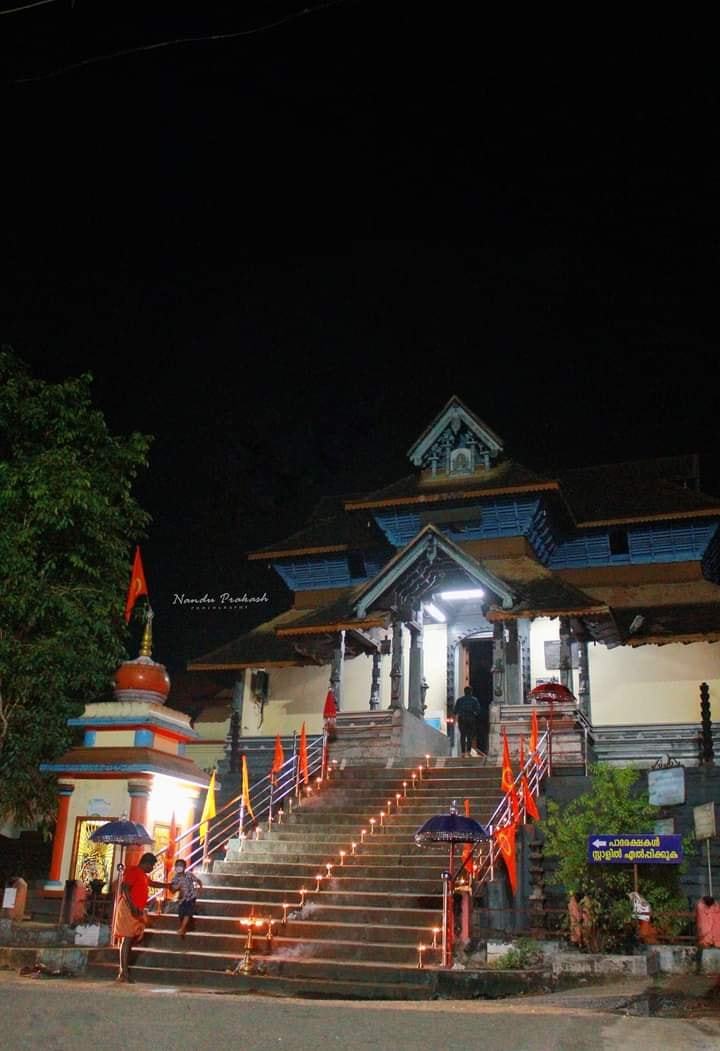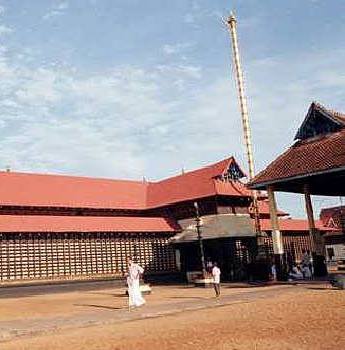Aranmula Parthasarathy Temple is a Hindu place of worship situated in Aranmula, a village within the Pathanamthitta District.

Aranmula Parthasarathy Temple is dedicated to Lord Krishna, who is revered as Parthasarathy, the charioteer of Arjuna. Built in the traditional Kerala architectural style, it is recognized as one of the "Divya Desams," which are the 108 temples of Vishnu honored by the Alvar saints.
As one of the most significant Krishna temples in Kerala, it ranks among the five ancient shrines associated with the Mahabharata legend, where it is believed that each of the five Pandavas constructed a temple.
Aranmula Temple is attributed to the Pandava prince Arjuna.
Each year, the sacred jewels known as Thiruvabharanam, belonging to Ayyappan, are carried in procession to Sabarimala from Pandalam, with Aranmula Temple serving as one of the key stops along this route. Additionally, the Thanka Anki, the golden attire of Ayyappan, which was donated by the king of Travancore, is kept here and transported to Sabarimala during the Mandala season in late December. Aranmula is renowned for its annual snake boat race, which takes place during the Onam festival and is associated with the legends of the Mahabharata. The temple features four towers positioned above its entrances on the outer wall.
Access to the Eastern tower is via a staircase of 18 steps, while the Northern tower can be reached through a flight of 57 steps that leads to the Pamba River. The temple's walls are adorned with paintings that date back to the early 18th century.
The temple operates from 4:00 AM to 11:00 AM and again from 5:00 PM to 8:00 PM, and it is managed by the Travancore Devaswom Board under the Government of Kerala. Aranmula Parthasarathy Temple is one of the five ancient shrines located in the Chengannur region of Kerala, associated with the narrative of the Hindu epic Mahabharata.
According to tradition, after installing Parikshit as the king of Hastinapura, the Pandava princes embarked on a pilgrimage. Upon reaching the banks of the Pamba River, it is said that each prince established a protective image of Krishna: Yudhishthira at the Thrichittatt Maha Vishnu Temple, Bheema at the Puliyur Mahavishnu Temple, Arjuna at Aranmula, Nakula at the Thiruvanvandoor Mahavishnu Temple, and Sahadeva at the Thrikodithanam Mahavishnu Temple. It is also believed that Arjuna constructed this temple to atone for the sin of killing Karna on the battlefield, which was against the principles of dharma regarding the slaying of an unarmed adversary.
Furthermore, it is said that Vishnu imparted the knowledge of creation to the god Brahma at this site, from whom the Madhu-Kaitabha demons subsequently stole the Vedas. The temple's image was transported to this location on a raft constructed from six bamboo pieces, which is the origin of the name "Aranmula" (meaning six pieces of bamboo). An alternative narrative suggests that the image was carried on a raft made of seven bamboo pieces, with one piece detaching approximately 2 kilometers upstream from the current site of the temple along the banks of the Pamba River. This location is referred to as "Mulavoor Kadavu," which translates to "river bank where the bamboo pole came off."
There are still descendants of a distinguished family of Ayurveda practitioners known as Mulavoor residing in that area. According to another legend, the name of the place is derived from "arin-villai," indicating a land situated near a river. Krishna, in his Vishvarupa form, is revered as "Annadana Prabhu" (The Lord who provides food) at this location, alongside other significant temples such as the Vaikom Mahadeva Temple and Sabarimala. It is widely believed that individuals who undergo Annaprashana at the Aranmula Parthasarathy temple will remain untouched by the hardships of poverty throughout their lives.
The Aranmula Mirror is also intricately linked to the temple's history. The king of Travancore intended to present a crown crafted from a rare metal to the temple and discovered a unique alloy of copper and lead. According to tradition, the creation of the polished metal mirror was a skill passed down through a single family. In contemporary times, the College of Fine Arts has begun to manufacture it on a commercial basis. The temple exemplifies the architectural style characteristic of Kerala, prevalent among temples in the South Indian state of Kerala along the eastern axis. It features an elevated design accessed by a flight of 20 steps.
The structure includes a two-storeyed gopuram, or gateway tower, with the upper level adorned with wooden trails that cover the Kottupura, a hall designated for drum performances during festivals. Surrounding the temple is a rectangular wall known as Kshetra-Madilluka, which is punctuated by gateways that enclose all the temple's shrines. Centrally positioned is the metal-plated flagpost, or Dwajasthambam, aligned with the temple tower and leading to the main sanctum, alongside a Deepastamba, which serves as a light post. The Chuttuambalam functions as the outer pavilion within the temple's confines.
The main shrine and its adjoining hall are situated within a rectangular structure referred to as Nallambalam, which features pillared halls and corridors. Between the entrance of Nallambalam and the sanctum lies a raised square platform known as Namaskara Mandapam, topped with a pyramidal roof. To the left of the Namaskara Mandapam from the entrance is Thevrapura, the kitchen responsible for preparing offerings to the deity. Additionally, Balithara serves as an altar for ritualistic offerings to demi-gods and festive deities. The central shrine, known as Sreekovil, enshrines the image of the presiding deity, a standing four-armed Lord Vishnu revered as Parthasarathy.
Annual Utsavam begins on the Atham Nakshatra in the month of Makara and lasts for ten days, concluding on the day of Thiruvonam. The highlight of this ten-day festival is the Garuda Vahanam Ezhunellippu, which occurs on the fifth day and is also referred to as Anchaam Purappadu. During this significant event, the deity is brought out from the sanctum sanctorum and placed on Garuda. It is believed that at this moment, all 33 million Devas, representing the elements of nature, along with the Gandharvas, gather in the temple to witness Lord Krishna as he rides on his vahana, the Garuda.
Malayalam month of Meenam is marked by a significant festival during which the Aranmula Parthasarathy is paraded in a magnificent procession on the Garuda mount to the banks of the Pampa river. Here, an idol of the Bhagawati from the nearby Punnamthode temple is also brought in procession for the Arattu festival.
Additionally, another notable celebration is the Khandavanadahanam, which takes place in the Malayalam month of Dhanus. For this occasion, a replica of a forest is constructed in front of the temple using dried plants, leaves, and twigs. A bonfire is then ignited, symbolizing the Khandavana forest fire from the Mahabharata.
ആറന്മുള ശ്രീ പാർത്ഥസാരഥി ക്ഷേത്രം
കേരളത്തിലെ ഏറ്റവും പഴക്കമുള്ള ക്ഷേത്രങ്ങളിലൊന്നാണ് ആറന്മുള ശ്രീ പാർത്ഥസാരഥി ക്ഷേത്രം. പത്തനംതിട്ട ജില്ലയിലെ ആറന്മുളയിൽ, പമ്പാനദിയുടെ തീരത്താണ് ഈ ക്ഷേത്രം സ്ഥിതിചെയ്യുന്നത്. ത്രിമൂർത്തികളിൽ ഒരാളായ ഭഗവാൻ മഹാവിഷ്ണുവാണ് ഈ ക്ഷേത്രത്തിലെ പ്രധാന പ്രതിഷ്ഠ. എന്നാൽ, ഭഗവാന്റെ ഒൻപതാമത്തെ അവതാരമായ ശ്രീകൃഷ്ണന്റെ പേരിലാണ് ഈ ക്ഷേത്രത്തിന്റെ പ്രശസ്തി. ചതുർബാഹു പ്രതിഷ്ഠയാണ് ഇവിടെ കാണുന്നത്, ഇത് ഗുരുവായൂർ ക്ഷേത്രത്തിലും സമാനമായി കാണാം.
തിരുവാറ്ന്മുളയപ്പൻ എന്ന പേരിലാണ് ഇവിടെ ഭഗവാനെ അറിയിക്കുന്നത്. കേരളത്തിലെ പ്രശസ്തമായ അഞ്ച് ശ്രീകൃഷ്ണക്ഷേത്രങ്ങളിലൊന്നാണ് ഇത്. ആറടിയിലധികം ഉയരം വരുന്ന വിഗ്രഹം, തന്റെ ഭക്തനായ അർജ്ജുനന് വിശ്വരൂപം കാണിച്ചുകൊടുക്കുന്ന സങ്കല്പത്തിലാണ് പ്രതിഷ്ഠിയ്ക്കപ്പെട്ടിരിക്കുന്നത്. കേരളത്തിലെ ശ്രീകൃഷ്ണക്ഷേത്രങ്ങളിൽ ഏറ്റവും വലിയ പ്രതിഷ്ഠ ആറന്മുളയിൽ സ്ഥിതിചെയ്യുന്നു. ഈ ക്ഷേത്രം ആറന്മുള പഞ്ചായത്തിലും, ക്ഷേത്രത്തിന്റെ മുൻഭാഗം മല്ലപ്പുഴശ്ശേരി പഞ്ചായത്തിലും ഉൾപ്പെടുന്നു. ആഗ്രഹങ്ങൾ സഫലമാക്കുന്നതിനായി നടത്തുന്ന ആറന്മുള വള്ളസദ്യ ഇവിടെ പ്രധാനമായ ഒരു വഴിപാടാണ്.
തിരുവോണത്തോണിയും, അഷ്ടമിരോഹിണി വള്ളസദ്യയും, കൂടാതെ ആറന്മുള ഉത്രട്ടാതി വള്ളംകളിയും ഇവിടെ നടക്കുന്ന പ്രധാന പരിപാടികളാണ്. ആറന്മുള കണ്ണാടി എന്നത് പ്രശസ്തമായ ഒരു ആകർഷണമാണ്. എല്ലാ വർഷവും ശബരിമലയിലെ അയ്യപ്പ പ്രതിഷ്ഠയ്ക്കായി ചാർത്തുന്ന തങ്ക അങ്കിയും വഹിച്ചുകൊണ്ടുള്ള ഘോഷയാത്ര ഈ ക്ഷേത്രത്തിൽ നിന്നാണ് ആരംഭിക്കുന്നത്. ഓണാഘോഷത്തോടനുബന്ധിച്ചുള്ള പ്രശസ്തമായ ആറന്മുള വള്ളംകളി ഇവിടെ നടക്കുന്നു. പതിനെട്ടാം നൂറ്റാണ്ടിലെ ചിത്രകാരന്മാർ വരച്ച നിരവധി ചുമർചിത്രങ്ങൾ ഈ ക്ഷേത്രത്തിൽ കാണാവുന്നതാണ്. തിരുവിതാംകൂർ ദേവസ്വം ബോർഡിന്റെ കീഴിലാണ് ഈ മഹാക്ഷേത്രം സ്ഥിതിചെയ്യുന്നത്.
മഹാവിഷ്ണുവിന്റെ ആറന്മുള വിഗ്രഹം ചതുർബാഹുവായ രൂപത്തിലാണ്. കുരുക്ഷേത്രയുദ്ധത്തിൽ ഗീതോപദേശത്തിനിടയിൽ അർജ്ജുനന് കാണിച്ച വിശ്വരൂപത്തിന്റെ പ്രതീകമാണെന്നു വിശ്വസിക്കുന്നു. ആറന്മുള ക്ഷേത്രം അർജ്ജുനൻ തന്നെ നിർമ്മിച്ചതാണെന്ന് പറയപ്പെടുന്നു. യുദ്ധത്തിൽ നിരായുധനായ കർണ്ണനെ കൊന്നതിന്റെ പാപഭാരം തീർക്കാനാണ് ഈ ക്ഷേത്രം സ്ഥാപിച്ചതെന്നു ഐതിഹ്യം പറയുന്നു. എന്നാൽ, ഈ വിഗ്രഹം ആദ്യം നിലയ്ക്കൽ എന്ന സ്ഥലത്ത് പ്രതിഷ്ഠിച്ചിരുന്നുവെന്നും പറയപ്പെടുന്നു. ഈ സ്ഥലത്തേക്ക് എത്തുന്ന ഭക്തർ, ക്രിസ്ത്യാനികൾ ഉൾപ്പെടെ, കാട്ടുജീവികളുടെ ഭീഷണി കാരണം നിലയ്ക്കൽ ഉപേക്ഷിച്ച് കാഞ്ഞിരപ്പള്ളിയിലും കടമ്പനാട്ടിലും താമസമുറപ്പിച്ചു. ഇതോടൊപ്പം ആരാധനാമൂർത്തിയും ഭക്തർ കൊണ്ടുപോയി.
ചാക്കന്മാർ ആറുമുളകൾ കെട്ടിയ ചങ്ങാടത്തിൽ വിഗ്രഹം കൊണ്ടുപോകുന്ന വഴിയിൽ, ഇന്ന് ക്ഷേത്രം സ്ഥിതി ചെയ്യുന്ന സ്ഥലത്തുനിന്ന് അല്പം പടിഞ്ഞാറായി തെക്കേക്കരയിൽ ഒരു മാടത്തിൽ വിളക്കു കണ്ടു. ചങ്ങാടം അടുപ്പിച്ച്, വിഗ്രഹം അവിടെ വച്ചു. വിളക്കു കണ്ട സ്ഥലത്തിന് ഇന്ന് വിളക്കുമാടം എന്ന പേരാണ്. വിഗ്രഹം ആറു മുളന്തണ്ടുകളിൽ കൊണ്ടുവന്നതിനാൽ, ഈ സ്ഥലത്തെ ആറന്മുള എന്ന പേരിൽ അറിയപ്പെടുന്നതാണ് ഐതിഹ്യം.
എന്നാൽ, പാർത്ഥസാരഥി ക്ഷേത്രത്തെക്കുറിച്ചുള്ള പുരാതന കാവ്യമായ തിരുനിഴൽമാലയിൽ ഈ ഐതിഹ്യത്തെയും വിഗ്രഹപ്രതിഷ്ഠയെയും സംബന്ധിച്ച യാതൊരു സൂചനയും കാണുന്നില്ല. കേരളീയ വാസ്തുവിദ്യയുടെ മികച്ച ഉദാഹരണങ്ങളിൽ ഒന്നാണ് ആറന്മുള പാർത്ഥസാരഥി ക്ഷേത്രം. ഇവിടെ സ്ഥിതിചെയ്യുന്ന പാർത്ഥസാരഥി വിഗ്രഹം ആറടി ഉയരമുള്ളതാണ്. ദർശനം കിഴക്കോട്ടാണ്. കുരുക്ഷേത്രയുദ്ധത്തിനിടെ അർജുനന് വിശ്വരൂപം കാണിക്കുന്ന ഭാവത്തിൽ ഈ വിഗ്രഹം സ്ഥാപിച്ചിരിക്കുന്നു. അതിനാൽ, ഉഗ്രഭാവത്തിലുള്ള ഭഗവാനായാണ് ഇത് കണക്കാക്കപ്പെടുന്നത്.
കേരളത്തിലെ ശ്രീകൃഷ്ണക്ഷേത്രങ്ങളിൽ ഏറ്റവും ഉയരമുള്ള വിഗ്രഹം ഇവിടെ കാണപ്പെടുന്നു. കിഴക്കേ ഗോപുരം കലാസൗന്ദര്യത്തിന്റെ പ്രതീകമായി ദാരുശില്പങ്ങൾ സമൃദ്ധമായി കാണപ്പെടുന്നു. കരിങ്കൽ തൂണുകളിലും കൊത്തുപണികളിലും അതിന്റെ സവിശേഷതകൾ പ്രകടമാണ്. ബലിക്കൽ പുരയിൽ കരിങ്കല്ലിൽ കൊത്തിയിരിക്കുന്ന വ്യാളികളുടെ പ്രതിമകൾ കേരളീയ ശില്പകലയുടെ വൈഭവത്തെ പ്രതിഫലിപ്പിക്കുന്നു. ക്ഷേത്രത്തിന്റെ ചുമരുകൾ പതിനെട്ടാം നൂറ്റാണ്ടിൽ വരച്ച മനോഹരമായ ചിത്രങ്ങളാൽ അലങ്കൃതമാണ്. കിഴക്കൻ ഗോപുരത്തിലേക്ക് എത്താൻ പതിനെട്ട് പടികൾ ഉണ്ട്. ചുറ്റുപാടുള്ള മണ്ണുകൊണ്ടാണ് ക്ഷേത്രത്തിന്റെ അടിത്തറ ഉയർത്തിയെടുത്തത്.
പമ്പാനദിയിൽ മഴവെള്ളം ഒഴുകുമ്പോൾ ക്ഷേത്രത്തിലേക്ക് പ്രവേശിക്കാതിരിക്കാനായി ഈ അടിത്തറ ഉയർത്തിയതാണ്. ഗണപതി, പരമശിവൻ, ശ്രീ ഭഗവതി (ദുർഗ്ഗ), അയ്യപ്പൻ, നാഗങ്ങൾ എന്നിവയാണ് ക്ഷേത്രത്തിലെ ഉപപ്രതിഷ്ഠകൾ.
ശ്രീകോവിലിന്റെ തെക്കുഭാഗത്ത്, തെക്കോട്ട് ദർശനമായി ഗണപതിയുടെ ഒരു രൂപം കൊത്തിയിട്ടുണ്ട്. വായുകോണിൽ ബലഭദ്രസ്വാമിയും, ഈശാന കോണിൽ നാഗദേവതകളും പ്രതിഷ്ഠിച്ചിരിക്കുന്നു. തെക്കുപടിഞ്ഞാറേ മൂലയിൽ കിഴക്കോട്ട് ദർശനമായി ശാസ്താവിനെ പ്രതിഷ്ഠിച്ചിരിക്കുന്നു.
അതിനു സമീപം കിഴക്ക് ദർശനമായി യക്ഷിയേയും, വടക്കുപടിഞ്ഞാറേ മൂലയിൽ ശ്രീഭഗവതിയേയും പ്രതിഷ്ഠിച്ചിരിക്കുന്നു. ക്ഷേത്രത്തിന്റെ വടക്കുവശത്തുള്ള കീഴ്തൃക്കോവിൽ, ക്ഷേത്രനിരപ്പിൽ നിന്നും 18 അടി താഴെയാണ്. ബലരാമനും പരമശിവനും ഗണപതിയുമാണ് ഇവിടത്തെ പ്രധാന പ്രതിഷ്ഠകൾ. പുരാതനമായ ബലരാമക്ഷേത്രം സ്വതന്ത്രക്ഷേത്രമായിരുന്നു, അതിനെ കേന്ദ്രീകരിച്ചാണ് ഇന്നത്തെ ക്ഷേത്ര സമുച്ചയം ഉയർന്നുവന്നത് എന്ന വിശ്വാസമുണ്ട്. വടക്കുകിഴക്കേ മൂലസ്ഥനത്ത് നാഗരമാണ് സ്ഥിതി ചെയ്യുന്നത്.
മകരമാസത്തിൽ നടക്കുന്ന ഉത്സവം അത്തം നാളിൽ ആരംഭിച്ച് തിരുവോണം നാളിൽ സമാപിക്കുന്നു. ഈ ഉത്സവം പത്തുനാൾ നീണ്ടുനിൽക്കുന്നു. പ്രധാന ചടങ്ങായ ഗരുഡവാഹനം അഞ്ചാം ഉത്സവനാളിൽ നടത്തപ്പെടുന്നു, ഇത് അഞ്ചാം പുറപ്പാട് എന്ന പേരിലും അറിയപ്പെടുന്നു. ഈ ചടങ്ങ് സ്ഥലവാസികൾക്കും ഉത്സവത്തിന്റെ ഭാഗമായാണ്. ഭക്തർ വിവിധ സ്ഥലങ്ങളിൽ നിന്നു വന്നു ചേരുന്നു. ഗരുഡവാഹനത്തിൽ വിഗ്രഹം ഉയർത്തുന്നതിന് പ്രത്യേക ശ്രദ്ധ നൽകുന്നു.
അഞ്ചാം ഉത്സവത്തിൽ പഞ്ചപാണ്ഡവർ ചേർന്ന് ഭഗവാനെ അഭിമുഖീകരിക്കുന്ന ആചാരമുണ്ട്. വർഷം തോറും ഉത്സവകാലത്ത് മുക്കുവർ നേർച്ചകളുമായി വരുന്ന ഒരു ചടങ്ങ് നടക്കുന്നു. ക്ഷേത്രാധികാരികൾ അവരെ യഥാസ്ഥിതിയിൽ സ്വീകരിക്കുകയും, അവർ സ്വർണ്ണത്തിലും വെള്ളിയിലും നിർമ്മിച്ച വല, നയമ്പ്, വള്ളം എന്നിവ സമർപ്പിക്കുകയും ചെയ്യുന്നു. സമുദ്രത്തിലെ അപകടങ്ങളിൽ നിന്ന് രക്ഷപ്പെടുന്നതിനുള്ള പ്രതിവിധിയായി ഈ ചടങ്ങിനെ കാണാം.
Address:
Mallapuzhassery, Kerala 689533



